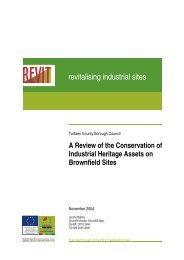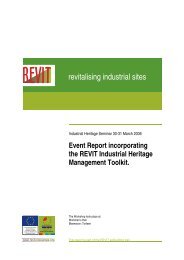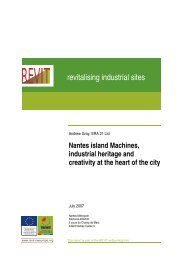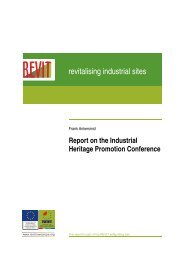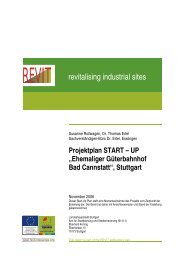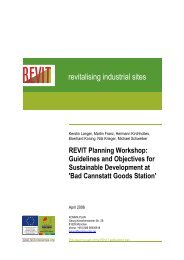REVIT Sustainable Evaluation Tool.pdf
REVIT Sustainable Evaluation Tool.pdf
REVIT Sustainable Evaluation Tool.pdf
You also want an ePaper? Increase the reach of your titles
YUMPU automatically turns print PDFs into web optimized ePapers that Google loves.
Regarding the methodology of sustainability measurement, two examples are cited:<br />
1. Methodology for Sustainability Integration and Appraisal developed by the Welsh<br />
Development Agency(WDA). The process of sustainable integration in this document is<br />
introduced as a more positive and realistic approach. This means:<br />
“finding ways of pursuing each objective with the minimum of harm to others, and where<br />
choices between objectives are inevitable, to be explicit and democratic about the<br />
choices”<br />
The process can also be defined as “Conflict Minimisation” – finding solutions which<br />
reduce (but not necessarily fully overcome) conflicts between different objectives. When<br />
key conflicts are identified, these are treated as a “Crunch Issue”, and ways of reducing<br />
or resolving them are searched for and agreed”.<br />
2. An alternative option to the methodology provided by the WDA is the tool for<br />
sustainability assessment developed by the RESCUE project team. The purpose of the<br />
RESCUE—Sustainability Assessment <strong>Tool</strong> (SAT) is to provide a methodology which<br />
considers sustainability criteria from a local and regional context perspective together<br />
with conflicting priorities to assess future brownfield regeneration projects in terms of site<br />
/ local specific sustainability. This approach provides support for funding and / or<br />
permission decisions. A full description of the SAT is available: www.rescueeuropa.com<br />
The process of agreeing on the sustainable objectives of a site has to be based on agreements<br />
achieved through discussion between institutional and non-institutional stakeholders affected by<br />
the project. The depth of participatory approach depends in reality on conditions such as owner<br />
attitude, scale of project and quality and level of local governance culture.<br />
To be sure that stakeholders participation will bring desired outcomes, the process has to be<br />
professionally designed and integrated with other project activities from earliest stages and<br />
adjusted to local conditions.<br />
To design and implement a process of stakeholder engagement it is advised to use professional<br />
guides and manuals providing theoretical overview of the topic together with practical indications<br />
regarding optimal project-specific conditions methods and tools. For example A <strong>Tool</strong> Kit for<br />
Stakeholder Engagement prepared by the <strong>REVIT</strong> project.<br />
This process of agreeing the sustainable objectives of a site may require a revision to the original<br />
objectives and in some cases altering or changing the vision for the site. The proposed process<br />
allows for cycles of changes to take place on an iterative basis. Once the objectives have been<br />
agreed then the appropriate tools and targets, indicators and measuring techniques can be<br />
selected. This in turn leads to a management plan to control this process throughout the duration<br />
of the project, reporting, variances to agreed tolerances, verifying compliance and reporting<br />
results. Finally an audit process will ensure that the results are verifiable and the sustainable<br />
benefits of the project are credible as well as ensuring that the project plan aims and objectives<br />
have been met.<br />
Produce Statement of Targets and Measures<br />
6



